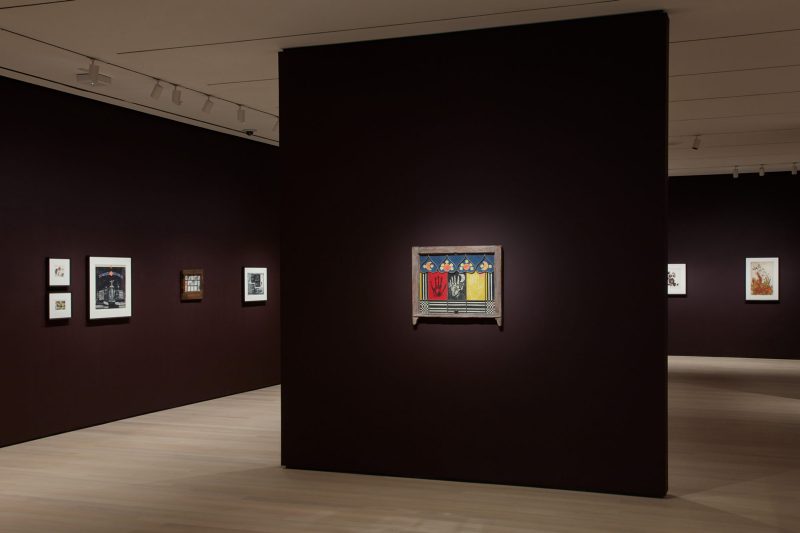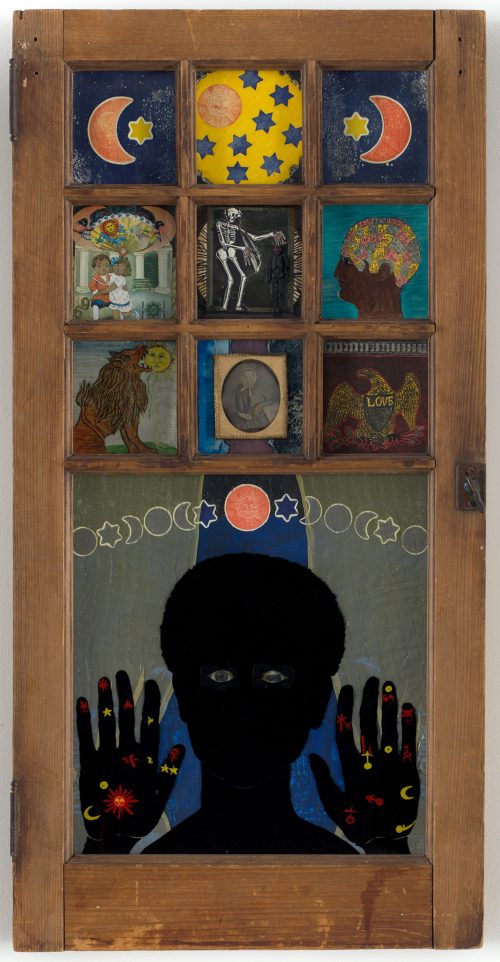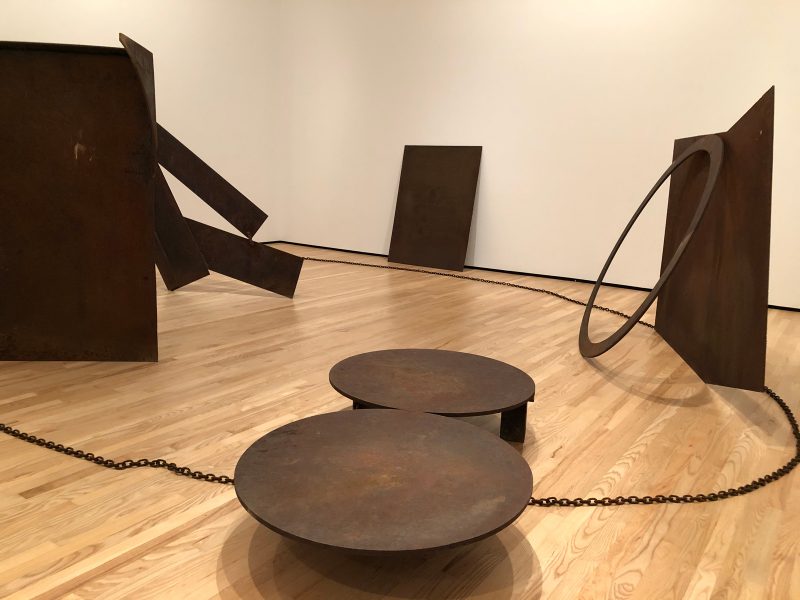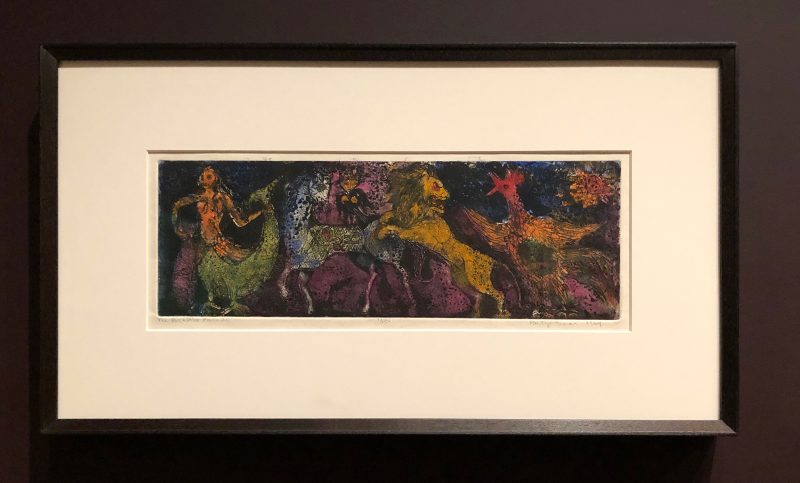
Betty Saar at MoMA
People might not realize that the legendary Betye Saar is an extraordinary printmaker, in addition to a maker of sculptural assemblages. The MoMA exhibition draws largely from their own collection of her prints, many created very early in her career, but the curators borrowed works from private collections too in order to enrich the show. Since drawings and prints on paper are highly light sensitive, they are often not on view. Saar became well known for her sculptural works impacted by her encounter with Joseph Cornell’s Surrealist boxes. In this exhibition, viewers can see images with which they likely are not as familiar.
There is no catalog for the show. This is typical of exhibitions drawn from a museum’s own collection and offers not only a way to balance out expensive shows with less costly ones, but also provides a rare opportunity for the public to see objects not usually displayed. In this case, the exhibition presents a recent acquisition by MoMA of 42 works on paper that demonstrate Saar’s experimental print practice. Printmakers particularly will love this show. Additionally, Saar herself comments on many of the works through a series of recordings available on a phone app and on MoMA’s website. Extended labels provide both the curator’s and the artist’s remarks.
An early, richly colored etching and aquatint print with hand additions is “The Beastie Parade,” 1964. It represents Saar’s exploration into the mystical and reveals not only the impact of historical etchings and medieval art, but also that of modern artists such as Kandinsky and Picasso. Saar examines the occult in these early years, and the bright colors enhance the maiden and animals depicted in the freeze-like composition.

Black Girl’s Window
The image that MoMA uses to represent the exhibition, “Black Girl’s Window,” (1969) is probably the most well-known work in the show. Although it is an assemblage, “Black Girl’s Window” includes not just a wooden frame and a found object (a plastic figurine), but also cut-and-pasted printed and painted papers, a daguerreotype, and a lenticular print. Lenticular prints provide an illusion of depth and the image appears changed when seen from different viewing positions. Saar said of this work: “Even at the time, I knew it was autobiographical.”* The composition refers to her family history, astrology, and death, demonstrating Saar’s belief that time is cyclical with history and experiences linking generations together.
Saar also explores racist tropes, including the pseudoscience of Phrenology, popular in the nineteenth century, which postulated that the shape and size of the cranium indicated character and mental abilities, bolstering the false belief that people who identified as Caucasians were superior to all other peoples. Saar explores this in several prints, including “The Phrenologer’s Window II.” In order to explain the artist’s many sources and ideas the exhibition includes a case with a Phrenology model and an earlier Phrenology print by Saar of a man’s head, among other artifacts.
In “The Palmist Window,” Saar employs a wooden window frame into which she inserts a collage of cut-and-pasted printed paper and fabric with charcoal and acrylic paint. She utilizes pattern and includes a Palmistry chart and a print of her own hand. Saar states that she is curious about things she does not understand, citing her inspiration for this assemblage as taken from the palm symbol on buildings where Romani people read palms in Los Angeles in the 1960s.* The subject supports her interest in the occult.
By 1972, when Saar created “Black Crows in the White Section Only,” she had developed powerful iconography to explore racism in the United States with this and another work that same year, the influential and historic “The Liberation of Aunt Jemima.” As a mother and artist, Saar turned to her art to address the politics of the time. In “Black Crows” she uses the device of a wooden window frame to set off the images: “This was a window that I found that had twelve small leaded panes. And I decided to put images in those windows of advertisements that are of a derogatory nature, of Black men.” ** The images used by Saar include a Black infant being used as alligator bait, a cigar box for a hambone, a banjo player, a Black person eating a watermelon, the American flag with a Klansman, and other imagery.
Melvin Edwards at Baltimore Museum of Art
Melvin Edwards, born eleven years after Betye Saar, also explores racism in his work, currently on view at the Baltimore Museum of Art. Edwards studied in California, moved to NYC in 1967, and began exhibiting his work very early in his career. Most notably, he is the first African American sculptor to have a solo exhibition at the Whitney Museum of American Art (1970). This exhibition addresses a series that Edwards made regarding his relationship with Africa and is largely derived from one on view at the Alexander Gray Associates Associates, NYC, in 2014.***

It begins with a room-size installation made up of five steel sculptures entitled “Homage to the Poet Leon Gontran Damas,” 1978-1981. Edwards became close friends with Damas who he met through his late wife and artistic collaborator, the poet Jane Cortez. Damas was originally from French Guiana and was one of the leading figures in the French Négritude movement, which questioned Colonialism and Western values and looked carefully at the arts and cultures of Africa. This installation symbolizes a gathering place and is meant for meditation. The solidity of the steel, placement of the forms, and the contrast between the geometric shapes and the metal chain provide an opportunity for contemplation within the museum environment. According to the wall text at the BMA, Edwards redesigns the layout of the work each time it is shown.
Following this gallery, the viewer encounters a long, rectangular room installed with mounted wall sculptures known as the “Lynch Fragments.” These are an ongoing series that Edwards has made since 1977 and which are often represented in art history texts. He divided the series over time into three parts: Civil Rights, Vietnam, and what he describes as “the complexities of Africa.” They are not large, but because of their complex compositions and materials, welded steel and found objects, demand attention. “Did Not Speak English,” includes a whole horseshoe and cut down horseshoes, a recurring object for the artist. The titles are very important. Here, the reference is clear—immigrants—who have fled difficult lives, but don’t necessarily speak English, and when they do learn the language, they speak with an accent. This often leads to disrespect, and although the work was made in 1988, it resonates today.
“Mali,” which includes a metal rake head turned on its side, was made in response to a trip he made to the country in West Africa in 2007, and where he visited Bandiagara, a World Heritage site; there the artist viewed the cliff dwellings of the Dogon people. For Edwards, symbols of agriculture have important meaning, especially the rake, which he sees as representative of civilization. Other implements, such as scythe blades and spade shovels appear in this series as well. The BMA has included text labels for each work, which are very important to fully experiencing Edwards’ sculptures, in that content is equally important to form.
A more recent work, another large installation, “Agricole,” 2016, culminates the exhibition. The title is the French word for “Agriculture,” and refers to the artist’s time in Dakar, Senegal, where he lived and farmed. But its chains and the fact that the piece hangs from the ceiling, suggests other meanings too. The hanging chains also infer lynching, and in that way connect to his Lynch Fragments. Even if you do not get a chance to see these exhibitions in person, you can view the two artists’ work in exhibition catalogs and books, and on the internet.
[ED. NOTE: This post has been corrected. Previously it stated that Edwards grew up on a farm in Texas. That was incorrect. The artist grew up in Dayton, Ohio, and Houston, Texas, before going off to college in Los Angeles. We apologize for the error.]
“Betye Saar: The Legends of Black Girl’s Window” October 21, 2019 – January 4, 2020. Museum of Modern Art, New York. Organized by Christophe Cherix, The Robert Lehman Foundation Chief Curator of Drawings and Prints, and Esther Adler, Associate Curator, with Ana Torok, Curatorial Assistant, and Nectar Knuckles, Curatorial Fellow, Department of Drawings and Prints.
“Melvin Edwards: Crossroads” From September 29, 2019 — January 12, 2020. Baltimore Museum of Art. Curated by Christopher Bedford, BMA Dorothy Wagner Wallis Director and Katy Siegel, BMA Senior Programing and Research Curator and Thaw Chair at Stony Brook University.
*Betye Saar on “Black Crows in the White Section Only.”
**Audio from the playlist “Betye Saar: The Legends of Black Girl’s Window.”
***“Melvin Edwards.”
More Photos






